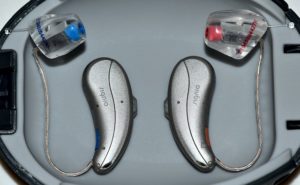To many, hearing aids seem miraculous. They help countless Americans cope with tinnitus, and enable many more to hear in spite of their hearing loss. Make no mistake—hearing aids are remarkable and complex technology. But this doesn’t mean we can’t gain a basic understanding of what makes them tick. Today, we’ll explain how hearing aids work in simple terms.

Hearing aids are remarkable and complex technology. But it’s not too hard to get a basic understanding of how they work!
The Microphone
These days, it’s easy to imagine a miniature microphone. Nearly all of us carry one around in our pockets. But when engineers first developed modern hearing aid technology, many were astounded that they could make a microphone small enough to fit in your ear.
If you want to know how hearing aids work, you should know that it begins with the microphone. This component of the hearing aid will pick up on environmental sounds. Its next task is to make you able to hear them, too.
The Amplifier
When was the last time you used a record player? If you ever dropped the needle on a record, and listened very closely, you could probably hear the music if you placed your ear close enough. But it’s too faint to make out in any detail. To hear it well, you’ll need the help of an amplifier.
The amplifier in your hearing aids does exactly what you’d expect; it amplifies sound to a volume at which you can hear it. It takes the nearby sounds picked up by the microphone, and makes them louder.
The Speaker
The last step in understanding how hearing aids work comes with the speaker. Alternately known as the receiver, it is from this component of your hearing aid that the amplified sound emits. It emits these sounds in the inner ear, which makes it far easier for individuals with hearing loss to make them out.
From there, your brain can do the rest. It will pick up on these amplified sounds and convert them into electrical impulses, which your brain will then process as audible sound.
As miraculous as they may seem, it is actually rather simple to understand how hearing aids work. Just remember that they contain three items you might have lying around the house: a microphone, an amplifier, and a speaker.
Contact Bay Area Audiology Today
Ready to change the way you look at hearing loss? Our Doctor of Audiology, Dr. Trisha A. Bents Muth, is exceptionally experienced in the art of audiology and is dedicated to providing the absolute best solutions. Bay Area Audiology has been working to give patients a comfortable environment with thorough evaluations. We are independently owned, and unbiased when it comes to finding you the care you need.
You can always come into the office or contact us in advance to set up an appointment. We also provide updates on our social media websites. You can check out our Facebook, Twitter, LinkedIn, and Pinterest to keep up with Bay Area Audiology.
Don’t hesitate–we can help.
